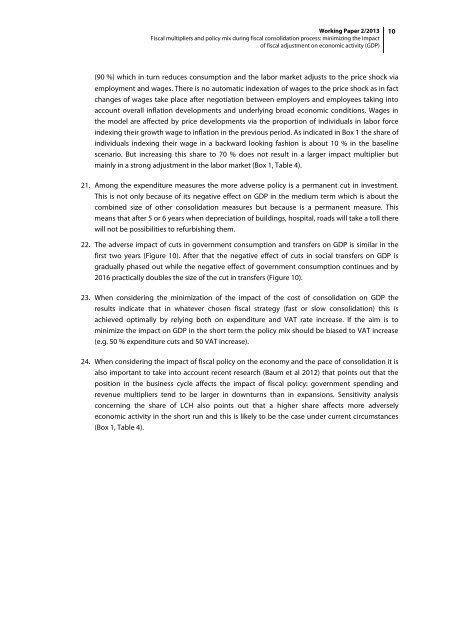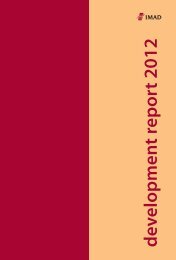Gonzalo C. Caprirolo and Marko Glažar Fiscal multipliers ... - UMAR
Gonzalo C. Caprirolo and Marko Glažar Fiscal multipliers ... - UMAR
Gonzalo C. Caprirolo and Marko Glažar Fiscal multipliers ... - UMAR
Create successful ePaper yourself
Turn your PDF publications into a flip-book with our unique Google optimized e-Paper software.
Working Paper 2/2013<br />
<strong>Fiscal</strong> <strong>multipliers</strong> <strong>and</strong> policy mix during fiscal consolidation process: minimizing the impact<br />
of fiscal adjustment on economic activity (GDP)<br />
10<br />
(90 %) which in turn reduces consumption <strong>and</strong> the labor market adjusts to the price shock via<br />
employment <strong>and</strong> wages. There is no automatic indexation of wages to the price shock as in fact<br />
changes of wages take place after negotiation between employers <strong>and</strong> employees taking into<br />
account overall inflation developments <strong>and</strong> underlying broad economic conditions. Wages in<br />
the model are affected by price developments via the proportion of individuals in labor force<br />
indexing their growth wage to inflation in the previous period. As indicated in Box 1 the share of<br />
individuals indexing their wage in a backward looking fashion is about 10 % in the baseline<br />
scenario. But increasing this share to 70 % does not result in a larger impact multiplier but<br />
mainly in a strong adjustment in the labor market (Box 1, Table 4).<br />
21. Among the expenditure measures the more adverse policy is a permanent cut in investment.<br />
This is not only because of its negative effect on GDP in the medium term which is about the<br />
combined size of other consolidation measures but because is a permanent measure. This<br />
means that after 5 or 6 years when depreciation of buildings, hospital, roads will take a toll there<br />
will not be possibilities to refurbishing them.<br />
22. The adverse impact of cuts in government consumption <strong>and</strong> transfers on GDP is similar in the<br />
first two years (Figure 10). After that the negative effect of cuts in social transfers on GDP is<br />
gradually phased out while the negative effect of government consumption continues <strong>and</strong> by<br />
2016 practically doubles the size of the cut in transfers (Figure 10).<br />
23. When considering the minimization of the impact of the cost of consolidation on GDP the<br />
results indicate that in whatever chosen fiscal strategy (fast or slow consolidation) this is<br />
achieved optimally by relying both on expenditure <strong>and</strong> VAT rate increase. If the aim is to<br />
minimize the impact on GDP in the short term the policy mix should be biased to VAT increase<br />
(e.g. 50 % expenditure cuts <strong>and</strong> 50 VAT increase).<br />
24. When considering the impact of fiscal policy on the economy <strong>and</strong> the pace of consolidation it is<br />
also important to take into account recent research (Baum et al 2012) that points out that the<br />
position in the business cycle affects the impact of fiscal policy: government spending <strong>and</strong><br />
revenue <strong>multipliers</strong> tend to be larger in downturns than in expansions. Sensitivity analysis<br />
concerning the share of LCH also points out that a higher share affects more adversely<br />
economic activity in the short run <strong>and</strong> this is likely to be the case under current circumstances<br />
(Box 1, Table 4).

















